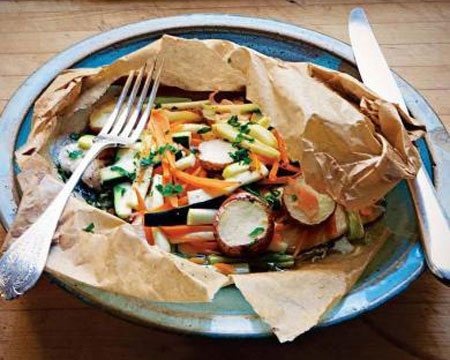Fillet Of Fish In Parchment
Fillet Of Fish In Parchment
Making a parchment envelope in which to steam a fillet of fish surrounded by aromatic vegetables may sound a bit fancy for just one, but cooking in parchment is actually one of the simplest and most effective ways of steaming, because it seals in the flavors. What a treat it is to have that golden-tinged, puffed-up half-moon of parchment on your plate, and then to tear it open and breathe in all the heady aromas. Moreover, you’ll have no cleanup afterward; just wipe off the Silpat mat and throw away the parchment after you’ve scraped and scooped up every last delicious morsel and its jus. If you want just one meal out of this, get about a 6-ounce fillet of flounder, halibut, salmon, red snapper—whatever looks good. Or, as I did recently, try tilapia, which is quite readily available these days and at a reasonable price. But bought almost twice the amount I needed, so I could play with the other half of the cooked fillet a couple of days later. I learned from Katy Sparks, whose book, Sparks in the Kitchen, is full of great cooking tips from a chef to the home cook, the trick of pre-roasting several slices of new potato so they can go in the parchment package. This way you have a complete, balanced meal-in-one cooked all together.
Servings
1

Ingredients
- olive
- 2-3 smallish new potatoes, cut into 1/2 inch slices
- salt and freshly ground black pepper
- one 6-ounce fillet of flounder, halibut, tilapia, salmon, or red snapper
- 1/3 medium zucchini, peeled and cut into very thin julienne strips
- 1 scallion, white and tender green parts only, cut into lengthwise strips
- 3 slices fresh ginger, approximately the size of a quarter, peeled and cut into julienne strips
- dash of white wine
- pinch of fresh herbs, such as parsley, chives, tarragon, or summary savory
Directions
- Preheat the oven to 425 degrees.
- Oil lightly the center of your Silpat mat set on a baking sheet, or, if you don’t have the mat, oil a piece of foil. Scatter the potato slices over the oiled area, then turn them. Salt and pepper lightly. Roast in the preheated oven for 10 minutes, turning once.
- Meanwhile, cut off an 18 inch piece of parchment paper, and fold it in half. Open it up, and on one half place the fish alongside the folded edge, after salting and peppering it on both sides. Pile the zucchini, carrot, scallion, and ginger on top of the fish, salt again lightly, and splash on enough wine to bathe the fillet(s) lightly. After the potato slices have had their 10-minute pre-roasting, arrange them on top or around the edge of the fish and sprinkle the herbs over all. Fold the other half of the parchment over, then fold in the open edge twice, and pleat it all around to make a semicircular airtight package. If it tends to open up where the folded edges meet, secure that place with a binder clip or a large paper clip. Place on the sheet pan, and bake for 12 minutes. If you have a fairly thick fillet, you may need to bake it 1-2 minutes more. Test with a skewer; if it goes in easily, the fish is done. Plunk the whole parchment package on a big dinner plate, and enjoy.
- Second Round
- You can make a delicious salad with the remaining fish. Arrange a bed of watercress or young arugula leaves on a salad plate, and set the fish on top. Take about 2 tablespoons mayonnaise thinned and tarted up with a little plain yogurt or lemon juice and seasoned with a small, finely chopped cornichon (or part of a dill pickle) and 1/2 teaspoon capers. Garnish with some strips of roasted red pepper—your own (see page 242) or from a jar—a few black olives, and some cherry tomatoes. Or try the Fish Salad recipe on page 157. These are just suggestions. Use your imagination, based on what you may have on hand. If you deliberately cooked more fish than you need, remove what you won’t want the first time around, and save it for a second round.